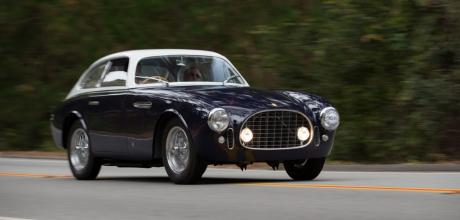1952 Ferrari 225 S Vignale Berlinetta
Early small-capacity V12 Ferraris feel very special indeed to drive, as we discover in a Vignale-bodied 225 S with a competition past. Story by Martin Buckley. Photography by Michael Ward.
Prancing Foal FERRARI 225 S A Vignale masterpiece driven
The proliferation of body styles and type numbers – never mind the blurred lines between racing sports cars and grand touring 'street' models – can make writing about early Ferraris a minefield if you don't know your Prunet and Tanner books off by heart. But if we accept that a true 'early' Ferrari is anything built between 1947 and 1954 with transverse leafsprung front suspension and chassis rails running under the rear axle (rather than over it), then we can definitively say that this Vignale-bodied, Colombo-engined 225 S is very much what comes to mind when you conjure up an image of a Maranello road car before the 250 GT family.
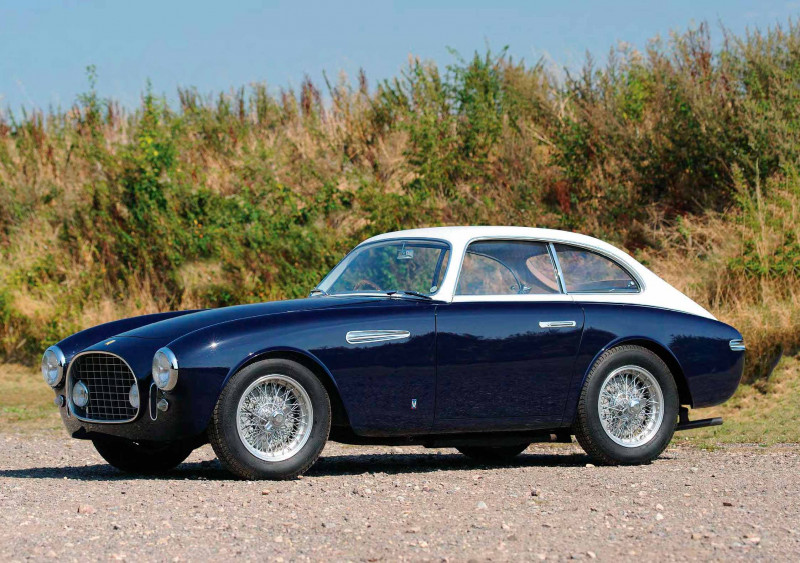
This 225 S was built for a Milanese aristocrat called Count Antonio Sterzi – Bruno to his friends – who was not only an early patron of the firm but also founder member of Scuderia Inter. Like many wealthy young men at that time, he wanted to take his new 2.7 million lire Ferrari racing without delay. Running temporary plates, its first outing (as car number 603) was an unsuccessful assault on the 1952 Mille Miglia, co-driven with Olympic bobsleigher Nino Rivelli.
“Chassis 0178ED had a two-year nut-and-bolt Ferrari Classiche restoration, good enough to be presented at Pebble Beach”
After a factory axle rebuild, chassis 0178ED – now properly registered as MI 193451 – redeemed itself by winning the Coppa della Toscana outright and the Bolzano hillclimb. At Monza in September, Sterzi won his class in the 225 S at the Coppa Inter Europa; there were other solid high finishing results in Italian races and hillclimbs that year, and then a final appearance in April 1953 at the Giro Sicilia. Chassis 0178ED then passed through the hands of the gentleman driver Siro Sbraci in 1954. In 1955, to Mimmo Dei of Scuderia Centro Sud in Rome sold it to an American collector called Carl Bross.

Originally built with an outside fuel filler and no boot lid, at some point the 225 S acquired both a lid and an inside fuel cap. The two-tone blue-and-white paint job, wind-down (rather than sliding) door windows and front indicators that it wears today were later additions, presumably intended to make it more user-friendly as a road car – and thus more saleable.
From here chassis 0178ED has a well-documented but chequered story, with at least 10 changes of ownership spanning Italy, America and back to Europe.
An interior fire in the late 1950s put this racing warhorse off the road for decades. At some point its body was restored in the US but it also 'lost' its engine in an era when few people were concerned about matching numbers. In the mid-1960s it was advertised in a dismantled condition for just $1500.
Latterly this little Ferrari's luck has dramatically improved. Chassis 0178ED was subject to a two-year nut-and-bolt restoration by Ferrari Classiche at Maranello on the instructions of its South American owner. The result was deemed good enough to be presented at Pebble Beach in 2016.
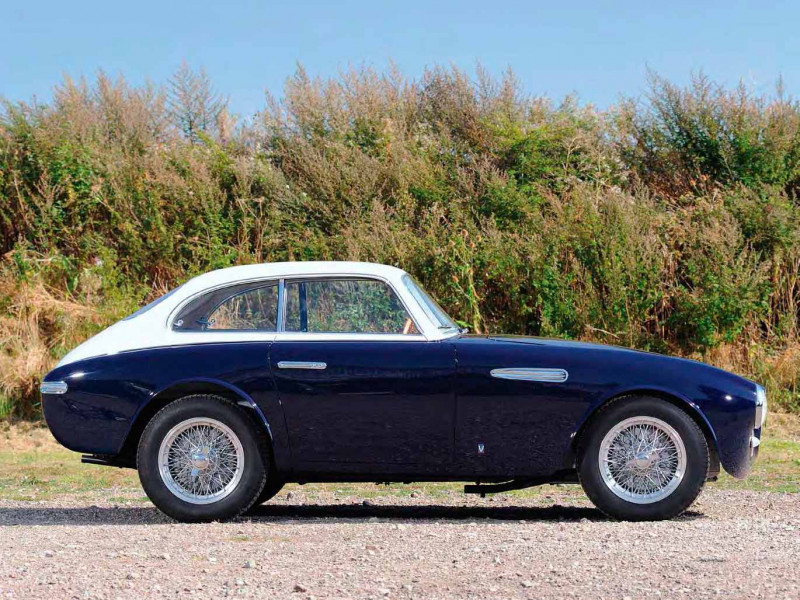
All 21 examples of the 225 S were produced in 1952. Vignale did 14 Spiders and six Berlinettas (like this one), while there was a single Barchetta attributed to Touring. Most of these cars have racing history, being fast and competitive enough to give works Jaguars and Astons a run for their money, even in the hands of privateers. A 225 S even handed Ferrari its first sports car win at Monaco.
The model is considered a derivative of the 212 Export and thus a direct descendent of the 195 and 166 in their various forms. Some of the 21 cars were directly converted from 212 Export models. The 225’s freer breathing and slightly larger 2715cc wet sump V12 had Lampredi-style roller type rocker arms. It ran an 8.5:1 compression ratio and with di-siamesed six-port cylinder heads (and sometimes two plugs per cylinder), it gave a healthy 210hp at 7200rpm.
Just two 225s had the tuboscocca chassis of welded-up tubes; the rest had a 212 Export-style spaceframe chassis comprising elliptical section tubes with main longerons and outriggers to carry the bodywork. The main chassis differences between the 212 and the 225 were the substitution of tubular dampers for Houdaille lever-arm units and larger 16- inch wheels to accommodate beefier drum brakes. You will notice that this Vignale-bodied Berlinetta, styled by Giovanni Michelotti, is right-hand drive. There was nothing unusual about this at the time because all Ferraris were RHD. But 1952 was significant as the year that exclusively right-hook steering was abandoned at Maranello, a local curiosity that had its origins in – among other things – snob value (Lancia and Alfa were also RHD only until the early 1950s) and compounded by an understandable wish to be able to see the edge of the road in a country of narrow cart tracks and deep ravines. But as Italian highways got wider and better surfaced, and the demand from wealthy North Americans increased, the RHD tradition was one Ferrari was happy to abandon and LHD began to be the default position.
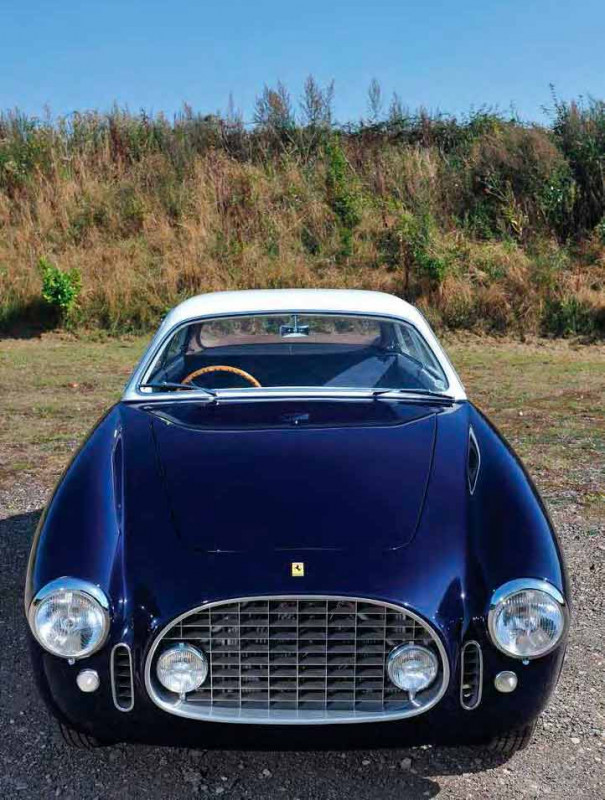
You naturally take a little time to look around and soak up the atmosphere of a car like this. It really is quite compact, like an MGB GT. Certainly most of today's small hatches would dwarf it. I don't consider it beautiful but the Michelotti shape does have presence. The classic eggcrate nose and sleek bonnet have a muscular sense of purpose about them but the rest of the body, teetering slightly on those tall, narrow Kleber-shod Borrani wires and that short wheelbase, just seems as if it’s along for the ride after a blind date with an early Standard Vanguard.
Attention soon turns to the engine, jewel-like yet rugged-looking at the same time. It sits well back and low relative to the bonnet and is dominated by three circular air boxes for its triple Weber carbs. Twin distributors driven off the ends of the camshafts provide sparks for one plug per cylinder, which are awkwardly positioned on the inside of the 'vee' so you have to fumble around under the carburettors to get at them; otherwise everything is simple and self-explanatory.
Ferrari Classiche went to great pains to recreate the long-lost interior of 0178ED accurately and has done a superb job, like the beautiful wool cloth headliner, lethal-looking Perspex sun visors, train carriage-style door locks, Bakelite door furniture and dashboard details.
The giant Jaeger speedometer and rev counter are the size of dinner plates. There are gauges for water, petrol and oil but the four or five knobs strewn across the remainder of the dash are unmarked. The exposed position of the various fuses and relays in the footwell are a legacy of the car’s competition life when the ability to fettle the electricals without having to stop and pop the bonnet was a definite bonus.
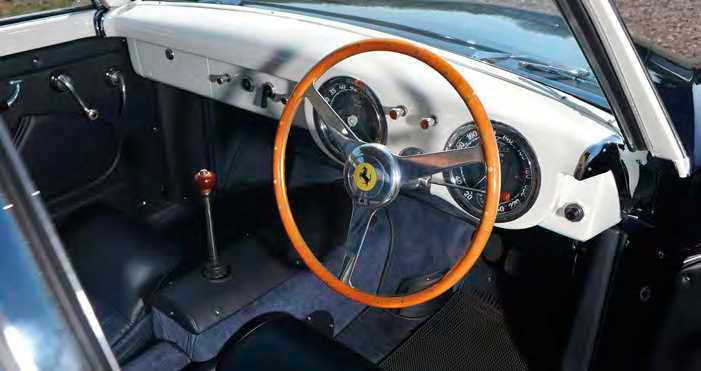
To start the engine, you push the big wind-up toy-style key in to get ignition lights and then press a button. A metallic whine brings the V12 to whooping life with that busy mix of chain, tappet and the smoothly natural little pistons. The long, straight shaft of the gear lever emerges assertively out of the carpet but with no six fingered gate; that came later.
You notice that the boxy construction of the scuttle makes the footwells seem pinched while the low bucket seats make you feel as if you are sat on the floor. Those pencil-thin roof pillars provide superb vision through 360 degrees.
Although it will pull cleanly and strongly from 1500rpm, this V12 is not suavely flexible but needs to be revved hard to get meaningful progress underway. The first four gears are well spaced but mostly unsynchronised. Held in third, it sings up the rev scale magnificently, pinning you firmly in your seat as you snatch fourth and let it wind out again to a conservative 5500rpm, clean and strong all the way with a sound that combines brawn and refinement in a visceral way that’s hard to forget yet difficult to describe.
I didn't use fifth gear, which I suspect is pointless under 60-70mph. Changing from first up to second and third down to second requires careful timing and clutch work to avoid noisy shifts. Presumably Ferrari stuck with a crash first, second and top because the changes are quicker when you do get it right. Luckily the revs flick round at the merest caress and once the oil has warmed up the gears hit home with a satisfyingly mechanical feel, so it’s worth the effort of getting it right.
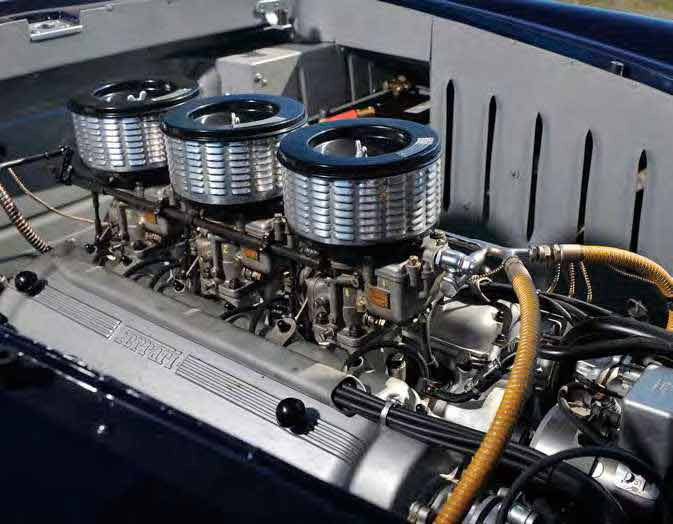
The beautiful alloy-spoked, wood-rimmed wheel is substantial in size, emerging on an eight-inch polished alloy column. The pedals are floor-hinged and set close together but the driving position is a good trade-off between comfort and the need to use your muscles to steer and stop the car. The brakes, clutch and throttle strike a fine balance between heft, progression and feel and the 225 S is not especially physically demanding to drive. In fact, it steers lightly and beautifully on those skinny little tyres, with very little roll and a feeling of well-balanced neutrality. It even manages to stop in a straight line and in short order.
When chassis 0178ED was being laid down in early 1952, the first chapter of Ferrari’s road car story was coming to a close and in many ways the 225 S was already out of date. Enzo Ferrari understood that he needed to become a road car manufacturer who built racing cars rather than a race car builder reluctantly producing sports cars to extract money out of wealthy clients. Increasingly these customers wanted sophisticated underpinnings to match the exotic engines. These were still years away (coil spring front suspension didn't arrive until 1954, for instance) but Ferrari’s engineers were beginning to think in terms of user-friendly synchromesh for the gearboxes and bigger, more flexible engines to maintain performance as the cars became heavier and more luxurious.
Increasingly, bodywork came courtesy of Pinin Farina, which clothed its first Ferrari (a rather sedate-looking 212 convertible) in 1952, paving the way for a formal partnership that persisted for 60 years. But as of 1952, it was Touring, Ghia and especially Vignale that dominated Ferrari styling. This was an undisciplined era that spawned almost as many horrors as it did catwalk beauties. Perhaps this 225 S has a wheel in both camps. But as a piece of history, a portal into the rarefied world of early Ferraris where the first owners were as exotic as their cars, it’s hard to fault.
2.7-litre V12 loves to rev and runs sweetly. View is dominated by air boxes for triple Weber carbs Many thanks to Classic Motor Hub (classicmotorhub.com) for their help with this feature
Jewel-like detailing is sublime. Even if the overall profile seems narrow and tall, it has a handsome air.


